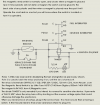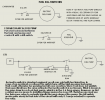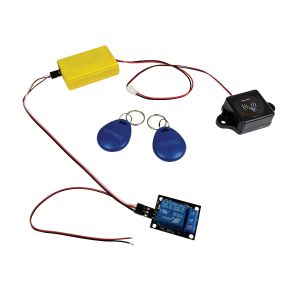Mach1 Driver
Well-Known Member
I got into a "discussion" with a very well known member over on the Big Forum about a circuit he was proposing that interrupted the power to the ignition. I tried to tell him nicely that it was basically useless, and why. He's a very smart guy and I figured if he didn't know, then most people didn't know, so as a public service, he ya go:
Kill Switches and Protecting your Car
It seems that everyone has their own opinion or philosophy about protecting their car…and you know what they say about opinions, but here is mine. Some people only insure their car and don’t even lock it, insisting that an accomplished thief will steal it if they want it. To me, that says they have no personal investment in the car- no blood, sweat, or pride of ownership. Mine is part of the family, a very old friend, and it’s MY CAR, not theirs for the taking. So here are the steps I have taken.
I believe you must have a layered approach, with as many layers as you can apply. Slow the thieves down and make it as difficult as possible. In this case, I believe that paranoia can be your friend.
1. Insurance: today's thieves could roll up with a car hauler and a GPS jammer. Unless you have your Mark 1000 Visual Acuity Devices trained on it (your eyeballs), your car will be gone. But most thieves aren’t that accomplished or prepared, and don’t need to be- it’s just too easy to steal a classic Mustang. So insure it and keep it in sight as much as possible when it is out of your garage.
2. Where you take it: don’t take it to the mall, theatre, supermarket, or other long term parking place. They only need seconds. When on a road trip, one of our members will take his car to the local police department and ask them to lock it in their secured parking overnight. He claims he has never been turned away as long as he offered them a ride.
3. Lock the hood: everything they need to steal the car is under the hood, so protect it. There is way too much mischief they can get into under there. I use a 76 Ford F350 truck hood latch. It has a cable going inside to a handle with a keyed lock. You also need a “helper spring” mounted to the hood. This pushes the hood up and away from the latch so the latch doesn’t re-engage as soon as you release the pull handle. Mid 70s Ford truck latches will bolt right into a 69-70 Mustang (YOU'LL HAVE TO CHECK IF YOUR YEAR DOES) and the same vehicle also has the helper spring. All I had to modify was the secondary safety release arm so it was easier to access.
4. Lock the doors: this is so obvious that I almost didn’t mention it. If you don’t give them an open invitation, they may move on. It’s just basic common sense.
5. Alarm: a noise maker is good- I like them. Even if other people don’t pay attention, you will. They can have vibration, and glass sensors, door, hood and trunk switches (remember to lock the hood anyway), and they can even call you if they sense an alarm or set off a GPS tracker. It’s all good stuff and part of the layering process. Where they fall short is how they attempt to actually prevent the car from running, and that will require a technical discussion on KILL SWITCHES. On the other hand, a system like LoJack is good (and expensive), but it doesn’t try to stop the theft, it just shows the cops where it is once you notify them it has been taken.
6. How cars are stolen: the method most often used is a jumper wire and a screwdriver. This is so ridiculously easy that you won’t believe it, and it literally only requires seconds. Here’s what they do:
(1) Lift the hood (that’s why you have to lock it).
(2) Put a jumper wire from the battery positive to the coil positive. This supplies power directly to your ignition system, and bypasses everything, including aftermarket alarms.
(3) Use a screwdriver to short from the front solenoid terminal to the “S” terminal. This cranks the engine to start it, and they are gone.
Seeing is believing, so here is a link to an 8-1/2 minute video, where he shows how to jack a 60s era car. It’s not a Mustang, but it has the SAME features. If anything, a Mustang is easier to steal because the coil and solenoid are up front. If you pay attention around 4:15, he talks about Fords. He’s a little long winded, but I find him entertaining, and everything he says is unfortunately accurate. As you’ll see, it takes him about 58 seconds to open the locked door, then the hood, start the engine and close the hood- all while explaining it and not rushing the process. PLEASE WATCH THIS
Below is a schematic (not a wire diagram) that shows why this is so simple and how it works. This is the ignition system for a classic Mustang:
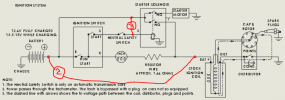
The jumper wire is #2, which connects the battery directly to the coil and bypasses everything else (ignition switch, alarm, whatever). The screwdriver is #3, which connects the battery to the solenoid “S” or coil terminal. This turns the solenoid on and the engine cranks for as long as the screwdriver is there. And away they go.
7. KILL SWITCHES: this is a kill switch used on a car with points. It is just a simple on-off toggle switch with one side connected to the chassis and the other side connected to the wire going between the coil and the points.
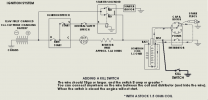
Don’t let this description throw you – this is just how the physical laws in our little corner of the universe work: The points have to open and close to make the magnetic field of the coil build and collapse to make a high voltage spark. With the kill switch closed the coil will stay on, but the field can’t collapse, so there is no transformer action in this DC circuit, so there is NO spark.
8. Kill Switches for other ignition systems: here are a few other popular ignition systems and how to disable them.
This would work for a Pertronix 1 as well. When I showed the example in #6 above to Pertronix, they were sure it would disable the car, but thought it may also damage the Pertronix module. They offered this solution instead:

and another
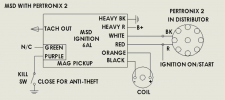
9. Fuel kill switches: there’s no magic here, just a switch to open the circuit to a pump or fuel solenoid.

I've run into a file size limit on the forum, so to be continued...
Kill Switches and Protecting your Car
It seems that everyone has their own opinion or philosophy about protecting their car…and you know what they say about opinions, but here is mine. Some people only insure their car and don’t even lock it, insisting that an accomplished thief will steal it if they want it. To me, that says they have no personal investment in the car- no blood, sweat, or pride of ownership. Mine is part of the family, a very old friend, and it’s MY CAR, not theirs for the taking. So here are the steps I have taken.
I believe you must have a layered approach, with as many layers as you can apply. Slow the thieves down and make it as difficult as possible. In this case, I believe that paranoia can be your friend.
1. Insurance: today's thieves could roll up with a car hauler and a GPS jammer. Unless you have your Mark 1000 Visual Acuity Devices trained on it (your eyeballs), your car will be gone. But most thieves aren’t that accomplished or prepared, and don’t need to be- it’s just too easy to steal a classic Mustang. So insure it and keep it in sight as much as possible when it is out of your garage.
2. Where you take it: don’t take it to the mall, theatre, supermarket, or other long term parking place. They only need seconds. When on a road trip, one of our members will take his car to the local police department and ask them to lock it in their secured parking overnight. He claims he has never been turned away as long as he offered them a ride.
3. Lock the hood: everything they need to steal the car is under the hood, so protect it. There is way too much mischief they can get into under there. I use a 76 Ford F350 truck hood latch. It has a cable going inside to a handle with a keyed lock. You also need a “helper spring” mounted to the hood. This pushes the hood up and away from the latch so the latch doesn’t re-engage as soon as you release the pull handle. Mid 70s Ford truck latches will bolt right into a 69-70 Mustang (YOU'LL HAVE TO CHECK IF YOUR YEAR DOES) and the same vehicle also has the helper spring. All I had to modify was the secondary safety release arm so it was easier to access.
4. Lock the doors: this is so obvious that I almost didn’t mention it. If you don’t give them an open invitation, they may move on. It’s just basic common sense.
5. Alarm: a noise maker is good- I like them. Even if other people don’t pay attention, you will. They can have vibration, and glass sensors, door, hood and trunk switches (remember to lock the hood anyway), and they can even call you if they sense an alarm or set off a GPS tracker. It’s all good stuff and part of the layering process. Where they fall short is how they attempt to actually prevent the car from running, and that will require a technical discussion on KILL SWITCHES. On the other hand, a system like LoJack is good (and expensive), but it doesn’t try to stop the theft, it just shows the cops where it is once you notify them it has been taken.
6. How cars are stolen: the method most often used is a jumper wire and a screwdriver. This is so ridiculously easy that you won’t believe it, and it literally only requires seconds. Here’s what they do:
(1) Lift the hood (that’s why you have to lock it).
(2) Put a jumper wire from the battery positive to the coil positive. This supplies power directly to your ignition system, and bypasses everything, including aftermarket alarms.
(3) Use a screwdriver to short from the front solenoid terminal to the “S” terminal. This cranks the engine to start it, and they are gone.
Seeing is believing, so here is a link to an 8-1/2 minute video, where he shows how to jack a 60s era car. It’s not a Mustang, but it has the SAME features. If anything, a Mustang is easier to steal because the coil and solenoid are up front. If you pay attention around 4:15, he talks about Fords. He’s a little long winded, but I find him entertaining, and everything he says is unfortunately accurate. As you’ll see, it takes him about 58 seconds to open the locked door, then the hood, start the engine and close the hood- all while explaining it and not rushing the process. PLEASE WATCH THIS
Below is a schematic (not a wire diagram) that shows why this is so simple and how it works. This is the ignition system for a classic Mustang:

The jumper wire is #2, which connects the battery directly to the coil and bypasses everything else (ignition switch, alarm, whatever). The screwdriver is #3, which connects the battery to the solenoid “S” or coil terminal. This turns the solenoid on and the engine cranks for as long as the screwdriver is there. And away they go.
7. KILL SWITCHES: this is a kill switch used on a car with points. It is just a simple on-off toggle switch with one side connected to the chassis and the other side connected to the wire going between the coil and the points.

Don’t let this description throw you – this is just how the physical laws in our little corner of the universe work: The points have to open and close to make the magnetic field of the coil build and collapse to make a high voltage spark. With the kill switch closed the coil will stay on, but the field can’t collapse, so there is no transformer action in this DC circuit, so there is NO spark.
8. Kill Switches for other ignition systems: here are a few other popular ignition systems and how to disable them.
This would work for a Pertronix 1 as well. When I showed the example in #6 above to Pertronix, they were sure it would disable the car, but thought it may also damage the Pertronix module. They offered this solution instead:

and another

9. Fuel kill switches: there’s no magic here, just a switch to open the circuit to a pump or fuel solenoid.

I've run into a file size limit on the forum, so to be continued...
Last edited:


